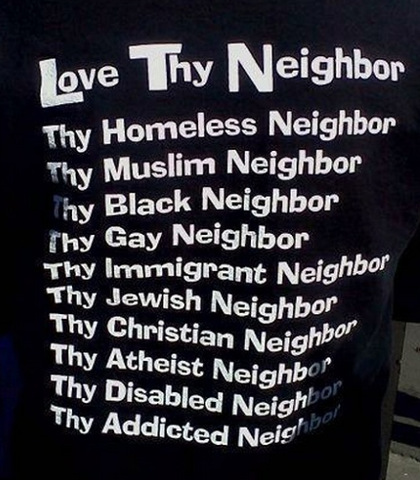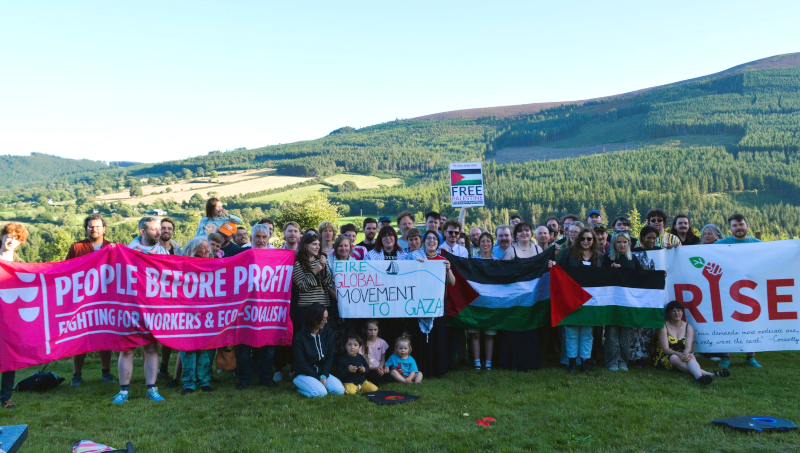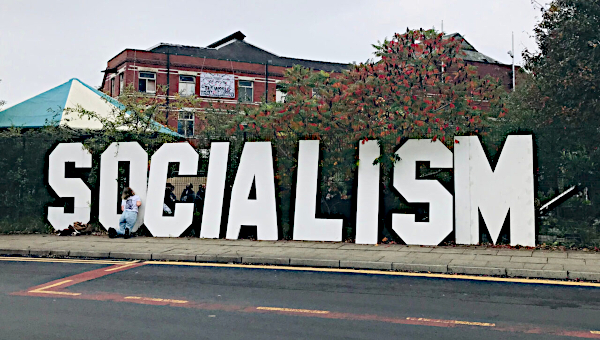“I think 9-11 [was] the first break in this planetary system. Now this is the second thing, which is the deep paradox. Where did [this break] come from? Maoism? Marxism? The revolutionary proletariat? The revolutionized peasantry? No, it comes from fucking religion – which we forgot about.” — “Interview With Stuart Hall,” Critical Quarterly, Dec 2007.
“Wherever the Syrian-Iraqi Islamist group Isis prevails, it mercilessly crushes and murders its enemies. But the group also has a social side: it inoculates children, fills potholes, installs new power lines and evaluates the quality of Kebabs.” — “Terror und Verbraucherschutz,” Sueddeutsche Zeitung, 17 June 2014.
Over the last few years, religion has gained in socio-political importance. For example, although the Tea Party in the U.S. had seemed to be in decline due to a determined counterattack by the Wall Street-affiliated Republican establishment, the Tea Party clearly demonstrated its influence with the surprising defeat of Eric Cantor, the Republican former majority leader in the House of Representatives. The Tea Party’s strength was further underscored by the subsequent burial of immigration reform, which had been promoted by major factions of capital.

Similarly, in Latin America, evangelical Christianity is becoming increasingly influential as a social movement. In Brazil a few years ago an evangelical candidate running for the Green Party (whose relative electoral success is often erroneously viewed as having led to the ‘greening’ of Brazilian political discourse) unexpectedly forced Dilma Rousseff into a run-off election. In sub-Saharan African countries, evangelical Christian forces are linked to the brutal persecution of LGBT-people (Uganda), and a wave of so-called ‘corrective rapes’ (South Africa).
In France, right-wing demonstrations have mobilized hundreds of thousands of people against gay marriage, especially members of the culturally conservative, Catholic milieu. In parts of Eastern Europe, a new block seems to be taking over power. It consists of the remaining fragments of the post-communist state apparatus, as well as nationalist-fascist movements, and church structures (whether Orthodox or Catholic), these of course remained relatively stable during communism. Finally, there is political Islam, which, spearheaded by the ‘global jihad’, has developed into a strong transnational movement. This movement has challenged governments with coups, bombings, civil wars and attempted revolutions throughout a wide geographical arc stretching from Mali to Malaysia.
Rise of Politico-Religious Movements
Whereas the global jihad is a transnational phenomenon, the U.S. Tea Party and the French homophobic demonstrations have arisen out of specific national contexts. Nevertheless, the current situation can be explained in the following manner: we are currently seeing a boom in what are mainly politico-religious movements. These movements, “aim to establish religious norms and laws in society, either through parliamentary or extra-parliamentary means” (Moghadam 2012, 104).
Reactionary movements are by no means the only religious movements that have gained in strength during the crises. The framework of religious structures and progressive movements in the United States is one example. It includes members of the civil rights and environmental justice movements, as well people affiliated with the current movement for a minimum wage. The discussions about Pope Francis, his
clear critique of capitalism and (what could be interpreted as a) progressive agenda, as well as the unbroken momentum and size of religious events in Germany, such as the Protestant Church Assembly – especially when compared to the ailing support for May Day – are further examples.
If we move away from the eternal battle lines that have been drawn between religion and the Left, we arrive at two basic questions. First, what characterizes the relationship between the Left and religion? Second, how can and should this relationship evolve in the future? Religious movements have never necessarily approached the Left with antagonism; instead, they have always been expressions of
social conflicts, and therefore form part of the contradictory terrain on which the struggle for hegemony is constantly fought. In Germany, however, the question of the Left’s relationship to religion does not need to be answered with the same urgency as in the Arab region, Latin America and Eastern Europe. Jan Rehmann’s (2014) point that there really is no chance of building a sustainable left-wing counter-hegemonic movement in the U.S. without a strong religious component cannot be directly applied to other regions of the world. Nonetheless, since movements of poor and marginalized
people are often religious movements, as Rehmann argues, the question of the Left’s abstract relationship is less about a critique of religion in the sense of Feuerbach, and more about the relationship of the Left to the ‘wretched of the earth’ – social groups that have traditionally provided the Left with its basis.
The Return of Religion Amidst the Organic Crisis
“Religious suffering is, at one and the same time, the expression of real suffering and a protest against real suffering. […] The criticism of religion is, therefore, in embryo, the criticism of that vale of tears of which religion is the halo” (Marx, A Contribution to the Critique of Hegel’s Philosophy of Right). Deep in the organic crisis without realistic perspectives for transformation, we are in the midst of such a vale of tears – an interregnum (Candeias 2010) – in which the old forms of orientation have become unsettled. This certainly means religious appeals have a good chance of resonating with everyday common sense. If an intellectually pessimistic analysis of current power relations and social trends can only describe the situation with very little hope, optimism (by will) can find expression in transcendental references to something that lies beyond the given. This, of course, is the core of the materialist theory of the return to religiosity. Gramsci knew that “the religious bond, which is loose in normal times, becomes stronger and more receptive during periods of great moral and political crises
when the future appears full of storm clouds” (Gef, 1, H1, §48: 124, German translation). In this situation – and this point is similar to Marx’s critique of the Young Hegelians – the weapons carried by the traditional criticism of religion fail, because they criticize the halo and not social relations.
Accordingly, the current organic crisis provides a framework that links various developments that are occurring at different times in different parts
of the world from the Arab region and Sub-Saharan Africa to Europe and the United States. At the same time, however, Hall argues that these developments are also intrinsically related to the current weakness of the Left, and particularly in fields that have historically strengthened its support. Hall (in this issue) contends, “With the defeat of secular alternatives, it [religion] became the focal point of resistance in some of the less developed parts of the world.” In short, the theory that religious forces are currently gaining in strength – at least in many parts of the world – is also a theory about declining left-wing influence.1
This is particularly clear in relation to the alleged basis of the Left in the everyday life of the ‘wretched of the Earth’, and this point is demonstrable in the following three areas.
Reproduction – Organization – Revolution
Reproduction: it has become common sense to assume that the strength of Hamas in the Gaza Strip is due to its introduction of forms of social welfare. Similarly, during the Egyptian Revolution, the point was made that whereas the Muslim Brotherhood had provided the walls of primary schools with a new coat of paint, the revolutionaries of Tahrir Square had merely covered the city’s walls with graffiti. Similar points can be made about Quran schools in Afghanistan and Pakistan. At the same time, political and structural reasons mean that the Left has been unable to formulate a convincing answer to the destruction of welfare-state structures in the so-called developing countries of the Global South, structures that had mainly benefited urban workers. Whether in Indonesia, Iraq, Egypt or Algeria, the neoliberal offensive has often been preceded by massive attacks against left-wing or communist structures. In fact, Islamist movements and organizations have even been actively promoted ‘from above’ with the aim of weakening the Left. In many places, this has cut off the Left from its basis, and led left-wing organizations to be broken up.
This of course represents one of the tragedies (in the literal sense of guiltless guilt) of left-wing politics.
At the same time, some of the movements in the Global South that were supported by the Left (from the north) have their basis in social groups that are (at best) less culturally disadvantaged than those that support movements organized by religion. In Turkey, for example, the culturally and economically disadvantaged poor from Anatolia form the basis of the moderate Islamist AKP; in contrast, the protesters from Gezi Park were mainly educated, urban middle-class “graduates with no future” (Mason 2011). Does this mean that the Left now represents the de-classed and the new middle classes, whereas the subaltern ‘lower classes’ have shifted their support to political religion? Although there are counter-examples, such as MST (the Brazilian Landless Worker’s Movement), and the movements of slum dwellers in South Africa, these are rare.
Organization: Institutions are needed in order to provide stable reproductive services; these institutions in turn both require and facilitate organization. In
North Africa, the question of the relationship between the Left and religious actors is at its sharpest: since the 1980s, the Egyptian
Muslim Brotherhood has set up all sorts of professional organizations, mosques, charitable structures and financial institutions. According to Daniljuk (2013), the Muslim Brotherhood:
“provides concrete help for poor people to solve everyday problems in urban slums, and rural areas. This last aspect, in particular, meant that
the Muslim Brotherhood was the only opposition organization able to fall back on nationwide structures at the beginning of the revolution
in January 2011, whereas the political coverage of left-wing organizations, for example, was limited to the major cities and the few industrial conurbations.”
These forms of organization provide reminders, if not echoes, of social democratic choral societies, undertakers and cooperative banks. The
weakness of left-wing organization, in this case the inability of the graduates to consolidate their political successes, was not because
they were organized as a network, as some traditional left-wing actors tend to argue. Rather, it was due to the absence of left-wing structures that supported the daily reproduction of the subalterns.
The current protest movements organized by the Brazilian middle class, for example, target their demands at a state that has been assigned
the role of ensuring the expanded reproduction of labour power and securing certain social rights. It was assigned this role by the
moral economy of the post-welfare and post-developing countries. In other words, the foundations of left-wing movements, which are
becoming ever more middle class, often fight for access to government support for their reproduction, whereas poorer and less powerful social groups have to look elsewhere, middle-bottom alliances are therefore difficult.
Revolution: the historical role of the radical left has always been to open up and maintain the possibility of fundamental systemic change, and as such provide a turning point in the sense of eschatology. However, “In
the West, the ability to think eschatologically seems to have been largely lost. It is hardly immanent in the Western way of life.
Regardless of the proneness to crisis and corruption in today’s liberalism, it is still extremely difficult to imagine life without
and beyond liberalism” (Mezzadra et al. 2013. 9). The understandable inability to develop convincing ‘immanent’ revolutionary or transformational perspectives in the organic crisis drives people
looking for fundamental change into the hands of social forces that tend to draw their perspectives for change from transcendence, regardless of how (un)realistic this may be.
This also characterizes the success of global rock stars of left-wing theory such as Negri, Žižek, Badiou and other ‘neo-comm(unist)s’,
who deploy numerous religious figures of argument. These include St. Paul and the messianic act, the portrayal of Lenin as Jesus, as well
as end time and the Horsemen of the Apocalypse. In doing so, they aim to establish or make use of the utopian surplus. This of course is
Bloch’s famous warm stream, which has largely been lost within the transformation Left. Despite the strategic vagueness of these
theorists’ concepts, their narratives have found great resonance, and they make the warm stream tangible. At the same time, these narratives appear to follow
a simple formula: if the historical structural situation of the world is becoming ever more religious, then why should this not be the case with the Left?
Two Questions for the Left
Religion has two functions (see Steckner 2013). On the one hand, it is an authoritarian, paternalistic power that promotes passivity among
subalterns and as such manufactures and stabilises domination. On the other, religion acts as a prophetic force that questions the status
quo and therefore encourages action among subalterns, which is why it can also form part of a left-wing, transformational mosaic and the struggle for hegemony.
This leads to a long-term and a short-term question. First, how can left-wing forces recapture lost ground in the areas of reproduction,
organization and revolution? The developments in Spain and Greece at least provide some promises of hope (see Candeias/Völpel 2014). Second, what form should the relationship between the Left and politico-religious forces take? Formulated differently, how can
emancipatory elements within religious movements be strengthened and productive ties to such movements be developed?
In answer to the first question, we are currently witnessing new connections between feminist and Marxist discourses and movements that could be described as ‘reproduction Marxism’. Accordingly, the field of reproduction/reproductive work has once again gained in importance for social struggles and left-wing
organization. Second, the question of organization is being discussed in (almost) all areas of the left-wing mosaic, and this is often being done productively. This situation is leading toward convergence and inclusion. Third, we need to look at the question of the revolutionary utopian warm stream. Our narrative of the world and the strategic options that are available to us are more convincing in
terms of content than those of the neo-comms or religious revival movements. However, the problem with the secular transformational Left is that in our useful but desperate attempt to relate what is feasible to what is necessary, we generate a narrative that is analytically correct, but not in Badiou’s sense, as it is not a truth with a significant truth-effect.
As such, it leaves the field of affective political engagement with the “non-cognitive-rational-based aspects” (Steckner 2013) of left-wing politics to other – often,
but not always – religious projects (and right-wing forces). In this sense, a whiff of elitism sometimes clings to the Left, because in the crisis it is often
difficult to build bonds between (the ‘struggles’ of) subalterns and ‘mediation intellectuals’ that are similar in strength to those formed by religion (see Porcaro 2011 31f; and Candeias/Völpel 2014, 209).
At least in the short and medium term, the revival of politico-religious movements is a fact that left-wing politics can hardly ignore, this
brings us to the second question. Gramsci formulated a classic strategic demand during a period in which the ‘destruction’
of religion was neither possible nor particularly desirable – problematic effects would occur if the function it fulfilled were no longer performed. Gramsci argued that: “We must therefore create ‘Catholic
radicals’, in other words ‘Popolare’, we must […] organize the peasant masses by ensuring that the priests do not merely remain spiritual leaders […] but also become social leaders” (Gef. 7, H.13, § 37: 1617).
In order to develop room for subaltern emancipatory action (in religious movements), it seems that alliances between left-wing and religious movements are indispensable. Of course, alliances cannot be forged with every organization. The Left should not climb into the same boat
as reactionary religious forces, for example, simply for the sake of an alliance. But even if the politico-religious field is dominated by movements that do not seem to lend themselves to emancipatory
alliances, the past provides many examples of where this has been done successfully. At the same time, the future certainly promises
previously unexplored effective alliances. For example, it is hard to imagine the development of a powerful movement aimed at achieving climate justice through socio-ecological transformation without including religious movements committed to the preservation of
creation. These groups no longer feel at home with the Green Party due to the necessary critique they express about the radical state of the ecological crisis.
In addition, numerous other ‘crossover projects’ exist, such as anti-capitalist Muslims who played a role in the Gezi protests, or the diverse remnants of liberation theological contexts in Latin America. At the same time, some large events, such as the German Protestant Church Assembly, also remain open to left-wing issues. A final example is the current special issue of the progressive Christian magazine Publik Forum entitled: Der Beutezug (The raid), which is focused on the TTIP free trade agreement. This special issue is supported by Attac, the Arbeitnehmer-Seelsorge Freiburg (Freiburg Worker’s Pastoral Care), Campact, the Christliche Initiative Romero (Christian Initiative Romero), INKOTA, Katholische Arbeitnehmer-Bewegung (Catholic Worker’s Movement), Katholische Landjugendbewegung (Catholic Rural Youth Movement), PowerShift, and the Sozialdienst katholischer Männer and Frauen Erkrath (Social Service of Catholic Men and Women Erkrath). Is this what a new part of the left-wing mosaic might look like? •
Translated by Eric Canepa.





